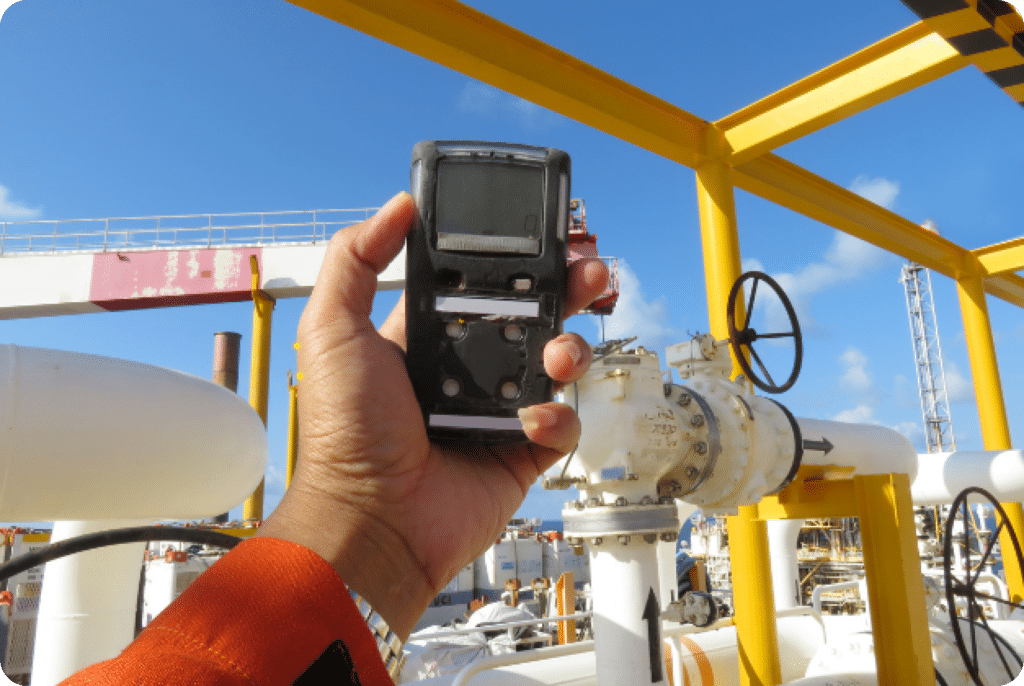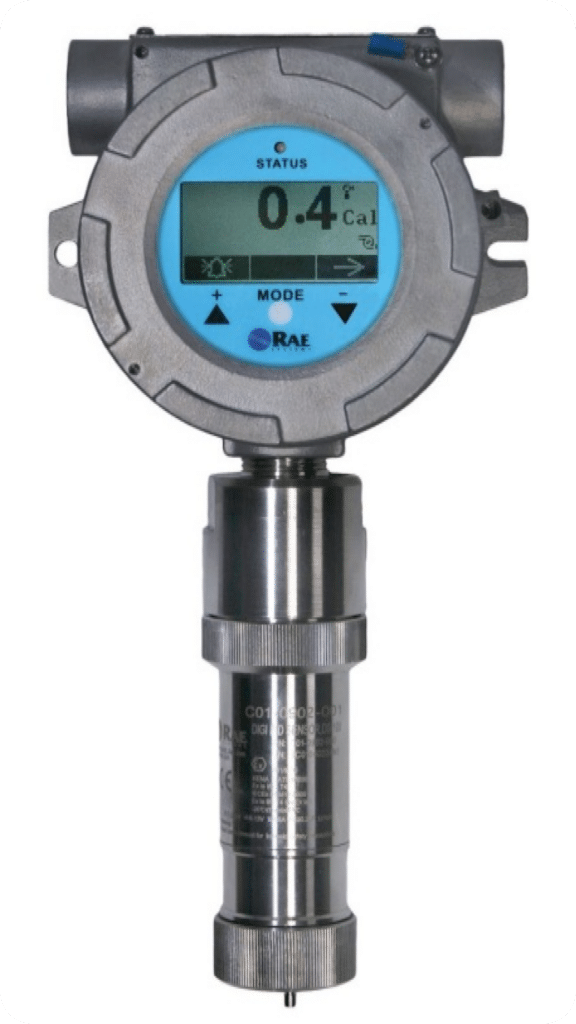Gas Detectors

Accidental gas leaks pose a huge threat to properties, environment and human life. Gas detection is an essential part of health and safety for the protection of human life and the environment. There are several different types of gases these systems and monitors can detect: oxygen depletion, combustible, flammable, and toxic gases. Gas detection devices are used across a number of industries and the key to risk assessments and safe practice.
A Gas Detector detects the presence of gases in an area can be used to detect a gas leak of combustible, flammable & toxic gases, and oxygen depletion. A gas detector is a safety device that can sound an alarm to operators in the area where the leak is occurring, giving them the opportunity to leave or follow the standard operating procedure to save life and machinery and interfaces with a control system so a process can be automatically shut down.
Detection Technologies To Detect
Combustible & Flammable Gas Leaks.
Electro Catalytic LEL Detectors
Catalytic bead (pellistor) sensors are commonly used to measure combustible gases that present an explosion hazard.
Electrocatalytic or “catalytic” detectors have been around for over 30 years and are widely used in a variety of industries as single-point detectors for combustible gases.
They function on the relatively simple and reliable principle that a combustible gas can be oxidized to produce heat. The resulting temperature change can be converted, via a standard Wheatstone Bridge, to a sensor signal. That signal can then be used to activate alarms and initiate fire preventative action.
Infrared LEL Detectors
An alternative method of measuring gas concentration is based on absorption of infrared (IR) radiation at certain wavelengths as it passes through a volume of gas.
Devices using this technology have a light source and a light detector and measure the light intensity at two specific wavelengths, one at an absorption (active) wavelength and one outside of the absorption (reference) wavelength.
If a volume of gas passes between the source and detector, the amount of light in the active wavelength falling on the detector is reduced, while the amount of light in the reference wavelength remains unchanged.
Toxic Gas & Oxygen Depletion Detectors
Toxic Sensors are electrochemical gas sensors that measure the concentration of a target gas by oxidizing or reducing the target gas at an electrode and measuring the resulting current.
Too much oxygen or oxygen depletion & toxic gas, such as hydrogen sulphide, chlorine, ammonia, hydrogen cyanide, Phosgene, etc. can present new dangers to employees and equipment in the area. Fortunately, finding the best sensor and monitoring system for your environment helps automate the process of gas detection and gives you peace of mind.
Industrial toxic gas and oxygen gas detectors monitor the presence of gases in a specified area and sound an alarm when they reach dangerous levels. Gas detectors are typically installed where there is a potential for a gas leak, and where unsafe gas levels pose an immediate danger to workers or equipment.

Photoionization (PID) Detectors

PID Portable Detector

PID Fixed Detector
VOCs (volatile organic compounds) are widely used in many manufacturing processes as solvents, propellants, fuels, bactericides, insecticides, etc. The Photoionization (PID) detector is an essential PPE (Personal Protective Equipment) for detecting and monitoring exposure to these dangerous substances.
Most of VOCs and organic vapors can be monitored via photoionization (PID lamp). The most widely used technology in VOC detectors is the 10.6 eV lamp, which has some disadvantages like the limitation to gases with an IP power < 10.6 eV, non-discrimination of monitored gases and high sensibility to relative humidity.
What is the need for detecting the VOC?
Volatile organic compounds are present in glues, paints, varnishes, household products, floor coverings, treated wood and are considered to be toxic pollutants. Their volatile nature allows them to propagate very easily in the atmosphere, hence the need to detect and measure them with a VOC monitor for better protection.
VOC used in many industries constitute toxic risks and their effects on health can vary depending on the substance. The dangers range from olfactory disturbance to mutagenic or carcinogen effects, and include risks like lung capacity reduction. The most dangerous organic vapors are formaldehyde, glycol ether, hydrocarbons (benzene, toluene, xylene, etc).
VOC toxicity carries the need for dedicated and appropriate VOC monitoring in order to avoid danger. A portable VOC detector is an essential personal protective equipment -PPE- to monitor exposition to these dangerous substances. These detectors are able to detect concentrations instantly, as well as monitor exposure limit values and occupational exposure limit values (ELV & OEL).
What Effects The Life Of Sensors?
Main factors that effects the sensor life
Environmental, dirt, dust and water impact.
Physical effects.
Gas exposure.
Catalytic sensors effected by poisons and inhibitors.
Temperature effect.
Humidity
Calibration drift.
Sensor electrodes and extreme vibration and mechanical shocks.
Barometric pressure
Repeated incidents of over exposure to temperature beyond the range will result in evaporation of the electrolyte and shifts in the baseline (zero) reading and slower response.
In high humid conditions water will be absorbed into the electrolyte causing dilution. In extreme cases the liquid content can increase by 2-3 times, potentially resulting in leakage from the sensor body, and then through the pins. In low humidity water in the electrolyte will begin to de-hydrate.
Sensor electrodes can in unusual conditions be poisoned by interfering gases that adsorb onto the catalyst or react with it creating by-products which inhibit the catalyst.
Extreme vibration and mechanical shocks can also harm sensors by fracturing the welds that bond the platinum electrodes, connecting strips (or wires in some sensors) and pins together.
How Does Sensor Replacement Take Place?
The sensor may only be replaced by a trained person. Electrochemical and catalytic sensors can be replaced simply by disconnecting the connector. After replacing the sensor, it is necessary to calibrate the detector.
In addition to regular recalibrations and sensor replacements, functional tests are also performed. The first is during the installation of the device, after starting and stabilizing the measurement, test gas is released on the sensor and the detector's response is monitored.
During the functional test and recalibration, the protective dust filter, which protects the sensor, is also checked for clogging. Running detectors without this filter reduces their life and will void the warranty. The filter is made of a special several-layer laboratory paper. At the same time, it often happens that customers confuse it with a plastic cover and throw the filter away.
In addition to regular recalibrations and sensor replacements, functional tests are also performed. The first is during the installation of the device, after starting and stabilizing the measurement, test gas is released on the sensor and the detector’s response is monitored.
When you want to know if your sensor is responding a bump test is a great option. This is simply a test that exposes the sensor to the specific gas it is intended to measure and ensure that the sensor does indeed respond. While not a precise process, this does ensure that the sensor is indeed responding and can respond in a critical situation where human safety is critical.
ATI offers an Auto-Test generator for many of the sensors used on the D12 and F12 monitors. This auto-test generator will produce a gas that causes the proper sensor to react. A test is run on a pre-set schedule, if the gas sensor does not respond as expected an alarm will come on indicating the sensor has failed. This is a great option for gas sensing for critical applications.
